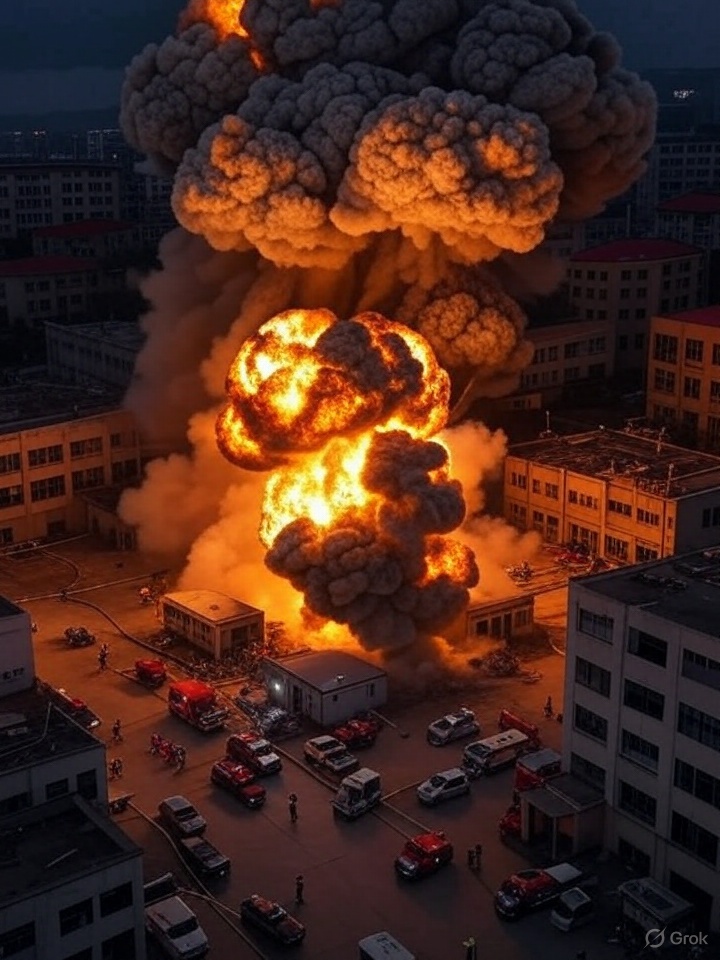A worker in China was killed on the spot due to the explosion caused by the flash of the mobile phone.
A tragic industrial accident in Sichuan, China, on January 7 led to the immediate death of a female worker at a titanium processing facility. The incident occurred when the worker attempted to document a leak on an oxygen liquefier, reportedly using her mobile phone, leading to a sudden and fatal explosion.
Details of the Tragic Incident
According to reports from Chinese authorities, the worker discovered a leak on the oxygen liquefier and intended to take a photograph with her mobile phone to send to management for repair instructions. Eyewitness accounts and video footage circulating after the event appear to show the worker approaching the equipment. A large blast occurred seemingly moments after she initiated the flash function on her device.
Explosion occurred at the Shandong Youdao

The Extreme Danger of Liquid Oxygen
This devastating event highlights the inherent and significant dangers associated with liquid oxygen (LOX). While crucial for various industrial and scientific applications, including its well-known use as an oxidizer in rocket propulsion systems, LOX is an extremely volatile substance under certain conditions. It is categorized as a hazardous and potentially explosive material, particularly in the presence of ignition sources or incompatible materials.
Liquid oxygen is a powerful oxidizer, meaning it can cause other materials that are normally non-flammable to burn rapidly and violently. Even small amounts of hydrocarbons, oils, or grease coming into contact with LOX can become explosive. An ignition source, even a seemingly minor one, can trigger a catastrophic reaction.
Potential Ignition Sources in Hazardous Environments
Industrial environments dealing with volatile substances like liquid oxygen must rigorously control all potential ignition sources. These can include:
- Static electricity discharge
- Sparks from electrical equipment
- Friction
- Open flames or hot surfaces
- Electronic devices not rated for hazardous areas
Mobile phones, like many standard electronic devices, are not typically designed to be intrinsically safe in environments where explosive atmospheres or highly reactive substances are present. Their batteries, circuitry, and even the flash function can potentially generate sparks or heat sufficient to ignite a volatile mixture.
The Importance of Strict Safety Protocols
Accidents like this underscore the critical importance of stringent safety protocols in facilities handling hazardous materials. Such protocols typically include:
- Hazard Identification and Risk Assessment: Thoroughly understanding the dangers posed by all substances handled.
- Designated Hazardous Zones: Clearly marking areas where dangerous materials are present.
- Equipment Restrictions: Prohibiting unauthorized or non-certified electronic devices in hazardous zones. Only intrinsically safe equipment designed to prevent ignition should be permitted.
- Training and Education: Ensuring all workers are fully trained on the specific hazards they face, safe handling procedures, and emergency protocols.
- Clear Communication Channels: Establishing safe and reliable methods for reporting issues like leaks without requiring personnel to introduce ignition sources into dangerous areas.
Using a standard mobile phone in close proximity to leaking liquid oxygen represents a profound safety breach with potentially fatal consequences, as tragically demonstrated by this event.
Lessons Learned from the Tragedy
This incident serves as a stark reminder of the unforgiving nature of hazardous industrial environments. It highlights the absolute necessity of adhering to established safety regulations, understanding the specific risks of materials like liquid oxygen, and recognizing the potential dangers posed by common items like mobile phones in such contexts. Industrial facilities must prioritize worker training and ensure that reporting procedures do not inadvertently create new hazards.
Summary
An explosion at a titanium processing company in Sichuan, China, resulted in the death of a female worker who reportedly used her mobile phone near a leaking liquid oxygen liquefier. The incident highlights the extreme volatility of liquid oxygen and the significant risk posed by potential ignition sources, including standard electronic devices like mobile phones, in hazardous industrial settings. Experts emphasize the critical need for strict adherence to safety protocols, comprehensive worker training, and prohibiting non-certified equipment in areas containing volatile substances to prevent such tragic accidents.
